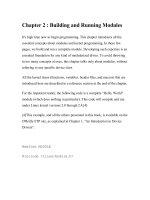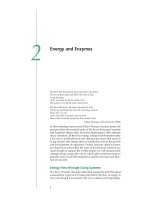Dbms chapter 2 storage and file structures
Bạn đang xem bản rút gọn của tài liệu. Xem và tải ngay bản đầy đủ của tài liệu tại đây (3.24 MB, 118 trang )
Ho Chi Minh City University of Technology
Faculty of Computer Science and Engineering
Chapter 2: Disk Storage and
Basic File Structures
Database Management Systems
(CO3021)
Computer Science Program
Dr. Võ Thị Ngọc Châu
()
Semester 1 – 2020-2021
Course outline
Chapter 1. Overall Introduction to Database
Management Systems
Chapter 2. Disk Storage and Basic File
Structures
Chapter 3. Indexing Structures for Files
Chapter 4. Query Processing and Optimization
Chapter 5. Introduction to Transaction Processing
Concepts and Theory
Chapter 6. Concurrency Control Techniques
Chapter 7. Database Recovery Techniques
2
References
[1] R. Elmasri, S. R. Navathe, Fundamentals of Database
Systems- 6th Edition, Pearson- Addison Wesley, 2011.
R. Elmasri, S. R. Navathe, Fundamentals of Database Systems- 7th
Edition, Pearson, 2016.
[2] H. G. Molina, J. D. Ullman, J. Widom, Database System
Implementation, Prentice-Hall, 2000.
[3] H. G. Molina, J. D. Ullman, J. Widom, Database Systems:
The Complete Book, Prentice-Hall, 2002
[4] A. Silberschatz, H. F. Korth, S. Sudarshan, Database
System Concepts –3rd Edition, McGraw-Hill, 1999.
[Internet] …
3
Content
2.1. Disk Storage
2.2. File Operations
2.3. Unordered Files
2.4. Ordered Files
2.5. Hash Files
2.6. Other File Structures
2.7. Today’s Storage Technologies
2.8. Physical Storage in Today’s DBMSs
4
2.1. Disk Storage
Databases
A collection of data and their relationships
Computerized
Stored physically on computer storage media
Primary storage
Secondary storage
Tertiary storage (Third-level storage)
The DBMS software can then retrieve,
update, and process the data as needed.
5
Computer Organization Hardware
Computer Architecture
ALU = Arithmetic/logic gate unit: performing
arithmetic and logic operations on data
6
2.1. Disk Storage
Memory hierarchy and storage devices
The highest-speed memory is the most
expensive and is therefore available with the
least capacity.
The lowest-speed memory is offline tape
storage, which is essentially available in
indefinite (without clear limits) storage capacity.
Primary storage level
Secondary and tertiary storage level
- Register
- Magnetic disk
- Cache (static RAM)
- Mass storage (CD-ROM, DVD)
- DRAM (dynamic RAM)
- Tape
7
2.1. Disk Storage
Types of storage with capacity, access time, max bandwidth
(transfer speed), and commodity cost
Table 16.1, pp. 545
[1] R. Elmasri, S. R. Navathe, Fundamentals of Database Systems- 7th Edition, Pearson, 2016.
8
2.1. Disk Storage
Storage organization of databases
Databases typically store large amounts of data
that must persist over long periods of time.
Persistent
data (not transient data which persists
for only a limited time during program execution)
Most databases are stored permanently (or
persistently) on magnetic disk secondary storage.
Database size
No permanent loss of stored data with nonvolatile storage
Storage cost
9
2.1. Disk Storage
Magnetic disks
Disks are covered with magnetic material.
The most basic unit of data on the disk is a
single bit of information.
By magnetizing an area on a disk in certain
ways, one can make that area represent a bit
value of either 0 (zero) or 1 (one).
To code information, bits are grouped into bytes
(or characters): 1 byte = 8 bits, normally.
The capacity of a disk is the number of bytes it
can store.
Whatever their capacity, all disks are made of
magnetic material shaped as a thin circular disk.
10
2.1. Disk Storage
(a) A single-sided disk with read/write hardware. (b) A disk pack with read/write hardware.
Figure 16.1, pp. 548, [1]
11
2.1. Disk Storage
Different sector organizations on disk.
(a) Sectors subtending a fixed angle.
(b) Sectors maintaining a uniform recording density.
Figure 16.2, pp. 548, [1]
12
2.1. Disk Storage
Magnetic disks
A disk is single-sided if it stores information on
one of its surfaces only and double-sided if both
surfaces are used.
To increase storage capacity, disks are assembled
into a disk pack.
Information is stored on a disk surface in
concentric circles of small width, each having a
distinct diameter. Each circle is called a track.
In disk packs, tracks with the same diameter on
the various surfaces are called a cylinder.
13
2.1. Disk Storage
Magnetic disks
A track is divided into smaller blocks or sectors.
The division of a track into sectors is hard-coded
on the disk surface and cannot be changed.
One type of sector organization calls a portion of a track
that subtends a fixed angle at the center a sector.
The division of a track into equal-sized disk
blocks (or pages) is set by the operating system
during disk formatting (or initialization).
Block size is fixed during initialization and cannot be
changed dynamically: from 512 bytes to 8,192 bytes.
14
2.1. Disk Storage
Magnetic disks
A disk with hard-coded sectors often has the
sectors subdivided or combined into blocks
during initialization.
Not all disks have their tracks divided into
sectors.
Blocks are separated by fixed-size interblock
gaps, which include specially coded control
information written during disk initialization.
This information is used to determine which block on
the track follows each interblock gap.
15
2.1. Disk Storage
Magnetic disks
Transfer of data between main memory and disk
takes place in units of disk blocks.
A disk is a random access addressable device.
The hardware address of a block = a
combination of a cylinder number, track number
(surface number within the cylinder on which
the track is located), and block number (within
the track)
For a read command, the disk block is copied
into the buffer; whereas for a write command,
the contents of the buffer are copied into the
disk block.
16
2.1. Disk Storage
Magnetic disks
The device that holds the disks is referred to as a hard disk drive.
A disk or disk pack is mounted in the disk drive, which includes a
motor that rotates the disks.
Disk packs with multiple surfaces are controlled by several
read/write heads—one for each surface.
Disk units with an actuator are called movable-head disks.
Disk units have fixed read/write heads, with as many heads as there are tracks.
A read/write head includes an electronic component attached to a
mechanical arm.
All arms are connected to an actuator attached to another
electrical motor, which moves the read/write heads together and
positions them precisely over the cylinder of tracks specified in a
block address.
Once the read/write head is positioned on the right track and the
block specified in the block address moves under the read/write
head, the electronic component of the read/write head is activated
to transfer the data.
17
2.1. Disk Storage
Magnetic disks
A disk controller, typically embedded in the
disk drive, controls the disk drive and interfaces
it to the computer system.
The controller accepts high-level I/O commands
and takes appropriate action to position the arm
and causes the read/write action to take place.
Locating data on disk is a major bottleneck
in database applications.
Minimizing the number of block transfers is
needed to locate and transfer the required data
from disk to main memory.
18
2.1. Disk Storage
Disk parameters
Block size:
B bytes
Interblock gap size:
G bytes
Disk speed:
p rpm
Seek time:
s msec
Rotational delay:
rd msec
Block transfer time:
btt msec
Rewrite time:
Trw msec
Transfer rate:
tr bytes/msec
Bulk transfer rate:
btr bytes/msec
(revolutions per minute)
19
2.1. Disk Storage
Disk parameters
Rotational delay: waiting time for the beginning
of the required block to rotate into position
under the read/write head once the read/write
head is at the correct track
rd
= (1/2)*(1/p) min
= (60*1,000)*(1/2)*(1/p) msec
= 30,000/p msec
20
2.1. Disk Storage
Disk parameters
Block transfer time: time to transfer the data in
the block once the read/write head is at the
beginning of the required block
btt = B/tr msec
If only useful bytes are considered, block transfer
time is estimated with bulk transfer rate.
btt = B/btr msec
21
2.1. Disk Storage
Disk parameters
Rewrite time: time for one disk revolution. This is useful in
cases when we read a block from the disk into a main
memory buffer, update the buffer, and then write the
buffer back to the same disk block on which it was stored.
In many cases, the time required to update the buffer in
main memory is less than the time required for one disk
revolution. If we know that the buffer is ready for
rewriting, the system can keep the disk heads on the
same track, and during the next disk revolution the
updated buffer is rewritten back to the disk block.
Trw = 2*rd msec = 60,000/p msec
22
2.1. Disk Storage
Disk parameters
Transfer rate: the number of data bytes
transferred in a time unit (msec)
23
2.1. Disk Storage
Disk parameters
Bulk transfer rate: the rate of transferring useful
bytes in the data blocks
btr = (B/(B+G))*tr bytes/msec
24
2.1. Disk Storage
The average time needed to find and transfer one block, given
its address, is estimated by: (s + rd + btt) msec
The average time needed to find and transfer any k blocks,
given the address of each block, is: k*(s + rd + btt) msec
The average time needed to find and transfer consecutively k
noncontiguous blocks on the same cylinder, given the address
of each block, is: (s + k*(rd + btt)) msec
The average time needed to find and transfer consecutively k
contiguous blocks on the same track or cylinder, given the
address of the first block, is: (s + rd + k*btt) msec
The estimated time to read k contiguous blocks consecutively
stored on the same cylinder, when the bulk transfer rate is
used to transfer the useful data, is: (s + rd + k*(B/btr)) msec
25









